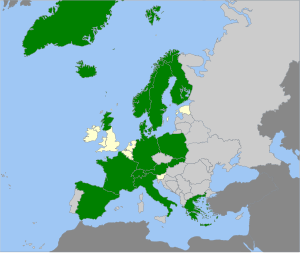Hochgebirgs-Spei-Täubling
| Hochgebirgs-Spei-Täubling | ||||||||||||
|---|---|---|---|---|---|---|---|---|---|---|---|---|

The high mountain Spei-Täubling ( Russula nana ) |
||||||||||||
| Systematics | ||||||||||||
|
||||||||||||
| Scientific name | ||||||||||||
| Russula nana | ||||||||||||
| Killerm. |
The Hochgebirgs-Spei-Täubling or dwarf-Speitäubling ( Russula nana , Syn .: Russula alpina ) is a fungus from the family of the Täubling relatives . It is a very small, red-capped species that can sometimes be found on alpine pastures. The Täubling enters into a symbiosis with herb willows or other creeping willows.
features
Macroscopic features
The hat is 2–4 (5) cm wide and colored bright pink to blood red. The middle is sometimes slightly purple in color and then fades to ocher or yellow. Sometimes the blubber is yellowish in color in the middle and pink on the edge, as is typical for some Chamaeleontinae . The smooth, shiny hat skin can be peeled off more or less easily, the flesh underneath is reddish in color.
The grown lamellae are fragile, dirty white or quickly grayish. The spore powder is pure white ( Ia after Romagnesi ).
The club-shaped, fragile stem is 2–3 cm long and 0.8–1.2 cm wide. It is slightly grayish white.
The meat is dirty white or dirty. It is almost odorless and tastes very hot in the typical form (var nana ). The alpina variety tastes milder and even has a slight odor. The guaiac reaction is without a characteristic expression.
Microscopic features
The spores are almost spherical to broadly elliptical, 8–11 µm long and 7–9 (–11.5) µm wide. They're usually quite networky. The basidia are 52–60 µm long and 13–16.5 wide and each have 4 sterigms . The cystides , which can be stained with sulfovanillin, are 100–130 µm long and 10–15 (18) µm wide.
In the cap skin there are clubbed, 0–1 (2) -septate Pileocystiden that are 6–11.5 µm wide and only react weakly with sulfovanillin. The cap skin hyphae are 2.5-3.5 µm wide and have blunt ends.
Ecology and diffusion
The Hochgebirgs-Spei-Täubling occurs on both acidic and lime-rich alpine lawns above the tree line up to an altitude of 2700 m. It enters into a symbiotic partnership with various creeping willow species , such as the herb or net willow . The Täubling is a purely Alpine or Nordic species that is relatively common in Norway, the Swedish mountains and Iceland and can only be found sporadically in the Alps in Central Europe.
In Germany it occurs only in the Bavarian Alps and curiously, albeit extremely rarely (RL1), in Saxony-Anhalt.
Systematics
The scientific species attribute ( epithet ) " nana " means dwarf or dwarf-like. The Latin noun is a loan word from ancient Greek ( νάννος ).
Inquiry systematics
The Hochgebirgs-Spei-Täubling is a representative of the subsection Emeticinae (Syn .: subsection Russula ). The subsection contains small to medium-sized, fragile species with red or pink hats and white spore powder. The pigeons taste very hot and usually have a pleasant, fruity smell.
Subspecies and varieties
- Russula nana var. Alpina (A. & Blytt face.) Bon (1986)
- With a width of 2–3.5 cm, the hat is somewhat smaller than that of the type species. It is dark red with an even darker center. The hat skin is smooth and sticky and shiny and can be peeled off a maximum of half. The almost dense, free lamellae have a yellowish sheen. The stem is club-shaped. In contrast to the type, the meat tastes almost mild.
meaning
Like all representatives of the Emeticinae , the Hochgebirgs-Spei-Täubling is not edible.
Web links
- Synonyms of Russula nana. Index Fungorum, accessed April 26, 2011 .
- Photo of Russula nana. Russulales News, accessed April 26, 2011 .
- Russula nana. In: Funghi in Italia / funghiitaliani.it. Retrieved on June 1, 2014 (in Italian, photos from Hochgebirgs-Spei-Täubling).
Individual evidence
- ↑ a b Monographic Key to European Russulas (1988). (PDF; 1.4 MB) The Russulales Website, p. 22 , archived from the original on July 28, 2010 ; Retrieved April 26, 2011 (English translation by M. Bons Russula key.).
- ↑ a b Russula nana. (PDF) Russulas. Micologia.biz Web de micología Europea, p. 88 , accessed on March 21, 2011 (Spanish).
- ↑ Russula nana. In: Russula database. CBS Fungal Biodiversity Center, accessed April 26, 2011 .
- ↑ a b Russula nana. In: Basidiomycota Checklist-Online / basidiochecklist.info. Retrieved August 2, 2011 .
- ↑ Torbjørn Borgen, Steen A. Elborne, Henning Knudsen: Arctic and Alpine Mycology . Ed .: David Boertmann, Henning Knudsen. tape 6 . Museum Tusculanum Press, 2006, ISBN 978-87-635-1277-0 , A checklist of the Greenland basidiomycetes, p. 37-59 .
- ↑ Worldwide distribution of Russula nana. (No longer available online.) In: data.gbif.org. Archived from the original on April 2, 2015 ; Retrieved August 21, 2011 . Info: The archive link was inserted automatically and has not yet been checked. Please check the original and archive link according to the instructions and then remove this notice.
- ^ Z. Athanassiou & I. Theochari: Compléments à l'inventaire des Basidiomycètes de Grèce . In: Mycotaxon . tape 79 , 2001, p. 401-415 ( cybertruffle.org.uk ). cybertruffle.org.uk ( Memento of the original from September 24, 2015 in the Internet Archive ) Info: The archive link was inserted automatically and has not yet been checked. Please check the original and archive link according to the instructions and then remove this notice.
- ↑ Nahuby.sk - Atlas hub - Russula nana. In: nahuby.sk. Retrieved September 27, 2012 .
- ↑ Ulla Taglich et al .: Red List of Large Mushrooms in the State of Saxony-Anhalt (PDF; 211 kB) In: sachsen-anhalt.de . 2004. Retrieved August 30, 2011.
- ↑ Russula nana in the PilzOek database. In: pilzoek.de. Retrieved August 21, 2011 .
- ^ Karl Ernst Georges: nanus . Detailed concise Latin-German dictionary. tape 1 . Hanover 1913, Sp. 3108 ( zeno.org ).
- Jump up ↑ Russula Part 5: Speitblings. In: The Tintling . Issue 95, issue 4/2015, pp. 29–38.
